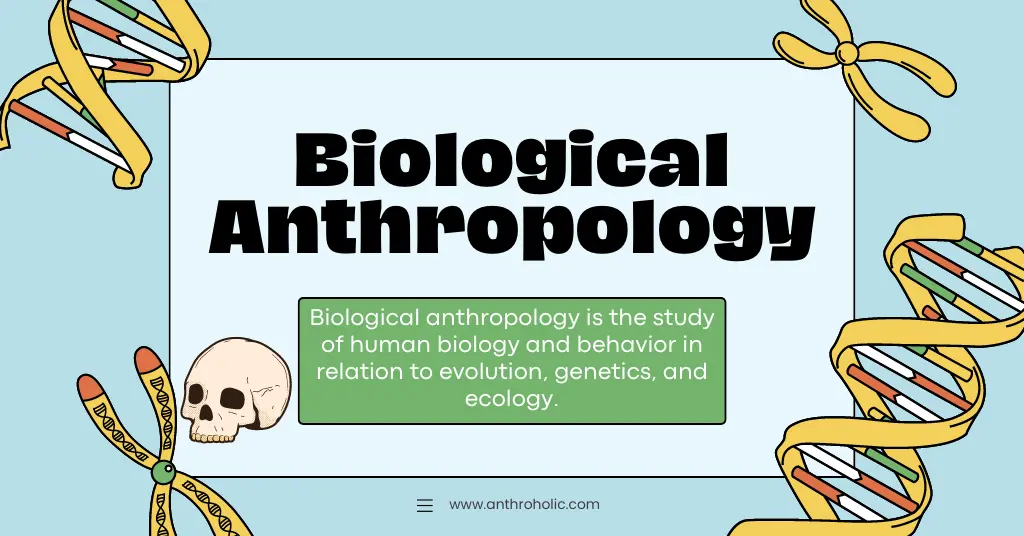AI Answer Evaluation Platform Live Now. Try Free Answer Evaluation Now
Biological Anthropology
Biological anthropology is the academic study of human genetics, behavior, and adaptation. It is a discipline of anthropology that focuses on the biological and physiological composition of individuals, as well as their genetic make-up and behavioral adaptations. This field of inquiry is also sometimes referred to as physical anthropology. The fundamental purpose of biological anthropologists is to understand biological and genetic differences within and among human groups, as well as how these variations have developed over time as a consequence of natural selection and other causes. They also explore the influence of cultural and environmental elements on human biology and health.

- Subfields of Biological Anthropology
- Origins of Biological Anthropology
- Anthropologist who studied it their contribution
- "New Physical Anthropology"
- What do Biological Anthropolgist do?
- Why is Biological Anthropology an Exciting and Rewarding Profession?
- What Opportunities Are There to Study Biological Anthropology?
- Timeline of important events and discoveries in Biological Anthropology:
- FAQs about Biological Anthropology
- Further Reading
Subfields of Biological Anthropology
Biological anthropology, commonly known as physical anthropology, is the study of human biology and behavior in relation to evolution, genetics, and ecology. The purpose of this discipline of anthropology is to grasp the biological basis of human variety and adaptation over time and place, from the earliest hominins to current humans. Biological anthropologists apply a variety of scientific methods, including genetics, anatomy, and ecology, to examine problems relevant to human evolution, behavior, and health. Each of the minor subfields within the greater discipline has its own study topics, methodology, and areas of specialization.
| Branches of Biological Anthropology | Description |
|---|---|
| Paleoanthropology | The study of human evolution through the examination of fossils, archaeological remains, and other evidence from past human populations. |
| Primatology | The study of non-human primates, including their behavior, social organization, genetics, and anatomy, in order to gain insights into human evolution, behavior, and biology. |
| Human Biology | The study of the biological variation within and between human populations, including genetics, physiology, and anatomy. |
| Forensic Anthropology | The application of biological and anthropological methods to the investigation of crimes and legal cases, including the identification of human remains, determining causes of death, and establishing the biological profile of individuals. |
| Biocultural Anthropology | The study of the interactions between biology and culture, including the ways in which cultural practices and environmental factors influence human biology and health. |
| Human Behavioral Ecology | The study of the evolution of human behavior, including the ways in which behavior is influenced by environmental and ecological factors. |
| Medical Anthropology | The study of the ways in which culture and society influence health, illness, and healing practices, as well as the ways in which biological and genetic factors interact with cultural practices and beliefs to shape health outcomes |
Origins of Biological Anthropology
The origins of biological anthropology can be traced back to the 19th century, with the emergence of the field of physical anthropology. Early physical anthropologists focused primarily on the measurement and classification of human skulls and bones, using these data to make inferences about the physical characteristics of different human populations. This approach, known as craniometry, was popularized by scholars such as Paul Broca and Franz Boas.
However, over time, physical anthropology expanded to encompass a broader range of topics, including human evolution, genetics, and ecology. The field was influenced by the discoveries of Darwin and Wallace, who proposed the theory of evolution by natural selection in the mid-19th century. This theory provided a framework for understanding the biological origins of humans and their relationship to other primates.
In the early 20th century, biological anthropology became more interdisciplinary, incorporating insights from genetics, anatomy, and physiology. With the advent of molecular biology in the mid-20th century, the field began to incorporate molecular genetics and genomics into its research programs. Today, biological anthropology continues to evolve, with new technologies and methods enabling researchers to explore questions related to human biology and behavior in increasingly sophisticated ways.
Anthropologist who studied it their contribution
| Anthropologist | Contribution to Biological Anthropology |
|---|---|
| Charles Darwin | Proposed the theory of evolution by natural selection, which provided a framework for understanding the biological origins of humans and their relationship to other primates. |
| Thomas Henry Huxley | Coined the term “anthropology” and was a prominent defender of Darwin’s theory of evolution. |
| Franz Boas | Discredited the idea of biological determinism and emphasized the importance of cultural factors in shaping human behavior. |
| Earnest Hooton | Conducted extensive research on human anatomy and physiology, including studies of human skulls and bones from around the world. |
| Sherwood Washburn | Conducted groundbreaking research on primate behavior and evolution, and helped to develop the field of primatology. |
| Jane Goodall | Conducted long-term studies of chimpanzee behavior in the wild, shedding light on the complex social lives of these primates. |
| Richard Lewontin | Conducted influential research on human genetic variation, challenging the notion of biological race and emphasizing the importance of environmental factors in shaping human biology. |
| Svante Pääbo | Led the team that sequenced the Neanderthal genome, shedding light on the evolutionary history of modern humans and their extinct relatives. |
“New Physical Anthropology”
“New Physical Anthropology” is not a term commonly used within the field. However, there have been several significant developments and changes within physical anthropology over the years that could be considered as “new” or innovative. Some examples include:
- The use of genetic and molecular approaches in studying human evolution and population genetics.
- The application of bioarchaeology, which combines techniques from physical anthropology, archaeology, and history to understand past populations and their lifestyles.
- The integration of biocultural perspectives, which recognizes the interaction between biology and culture in shaping human diversity and adaptation.
- The adoption of new technologies and imaging techniques, such as computed tomography (CT) scanning and 3D printing, to study skeletal remains and anatomical structures.
These are just a few examples of how physical anthropology has evolved and adapted over time to incorporate new methods, technologies, and perspectives.
What do Biological Anthropolgist do?
Biological anthropologists study the biological and behavioral aspects of human beings, both past and present. They examine the physical and genetic traits of humans and their close relatives, such as primates, to better understand human evolution, variation, and adaptation. Some specific tasks of biological anthropologists include:
- Conducting fieldwork to collect data on human biology, behavior, and cultural practices.
- Analyzing genetic data to understand human ancestry and evolution.
- Examining human skeletal remains to understand patterns of health, disease, and injury in the past.
- Studying primate behavior to better understand human social behavior.
- Investigating the impact of environmental factors on human biology and health.
Overall, biological anthropologists use a combination of laboratory research, fieldwork, and data analysis to gain a better understanding of human biology and evolution.
Why is Biological Anthropology an Exciting and Rewarding Profession?
As a field that explores the biological and evolutionary aspects of humans and primates, Biological Anthropology offers a unique perspective on the origins, development, and diversity of humankind. It provides a fascinating insight into the biological and genetic mechanisms underlying human traits, behaviors, and cultures. Studying Biological Anthropology allows one to appreciate the complex interplay between biological, environmental, and cultural factors in shaping human evolution and adaptation. Moreover, the field has significant practical applications, such as in medicine, forensics, and conservation. Being a Biological Anthropologist offers an opportunity to make significant contributions to the scientific understanding of humanity and to address important issues facing society today.
What Opportunities Are There to Study Biological Anthropology?
There are various opportunities to study biological anthropology. Students can pursue undergraduate and graduate degrees in biological anthropology at universities and colleges worldwide. These programs provide training in human biology, evolution, genetics, anatomy, and other related fields. Additionally, there are various research opportunities for students interested in pursuing a career in biological anthropology. These opportunities include internships, fieldwork, and research assistant positions. Professional organizations, such as the American Association of Physical Anthropologists, also provide resources for students and professionals interested in the field.
Timeline of important events and discoveries in Biological Anthropology:
- 1859: Charles Darwin publishes “On the Origin of Species”, which outlines his theory of evolution by natural selection.
- 1871: Darwin publishes “The Descent of Man”, in which he applies his evolutionary theory to humans.
- 1883: Francis Galton published “Inquiries into Human Faculty and Its Development”, which established the field of eugenics.
- 1900: The rediscovery of Gregor Mendel’s work on genetics provides a foundation for the study of human genetics.
- 1920s-1930s: Physical anthropologists begin to use the scientific method to study human biology and evolution.
- 1950s: The discovery of the structure of DNA by James Watson and Francis Crick revolutionizes the study of genetics.
- 1953: Sherwood Washburn introduces the concept of “primate behavior and ecology” in physical anthropology.
- 1960s: The study of primate behavior becomes a major area of research in biological anthropology.
- 1970s: The development of DNA sequencing technology allows for the study of genetic variation within and between populations.
- 1980s: The concept of “biocultural evolution” is introduced, emphasizing the interaction between biology and culture in human evolution.
- 1990s: Advances in molecular biology allow for the study of ancient DNA, providing new insights into human evolution.
- 2000s: The completion of the Human Genome Project provides a wealth of information about human genetics and evolution.
- 2010s: The study of epigenetics, or the study of changes in gene expression that are not caused by changes in DNA sequence, becomes an important area of research in biological anthropology.
FAQs about Biological Anthropology
Further Reading
- “Biological Anthropology: The Natural History of Humankind” by Craig Stanford, John S. Allen, and Susan C. Antón.
- “The Human Career: Human Biological and Cultural Origins” by Richard G. Klein and Brian M. Fagan.
- “Primate Adaptation and Evolution” by John G. Fleagle.
- “The Evolution of Human Sexuality” by Donald Symons.
- “Evolutionary Medicine” edited by Wenda R. Trevathan, E.O. Smith, and James J. McKenna.
- “The Story of the Human Body: Evolution, Health, and Disease” by Daniel E. Lieberman.
- “Biological Anthropology and Aging: Perspectives on Human Variation over the Life Course” edited by Douglas E. Crews and Ralph M. Garruto.
- “The Evolutionary Biology of Human Female Sexuality” by Randy Thornhill and Steven W. Gangestad.
- “Human Biological Variation” edited by James H. Mielke.
- “The Primate Fossil Record” edited by Walter C. Hartwig.




